Remote monitoring through drone surveillance offers game-changing benefits for construction site management. You'll gain a bird's-eye view to quickly spot safety hazards, track progress, and enhance security. To get started, choose a drone with sufficient flight time, high-resolution camera, and durability for site conditions. Make sure you comply with FAA regulations and obtain necessary permits. Implement thorough flight planning, safety checks, and data collection techniques. Process and analyze images to optimize project management and integrate findings with your software systems. Train operators in regulations and practical skills. Proper maintenance will keep your equipment reliable. The sky's the limit for improving your construction site oversight.
Benefits of Drone Surveillance

Numerous construction companies are turning to drone surveillance for remote monitoring of their sites. You'll find that this technology offers a wide range of benefits for your construction projects. Drones provide a bird's-eye view of your entire site, allowing you to quickly identify potential safety hazards, track progress, and monitor equipment usage.
They're also invaluable for surveying and mapping, helping you create accurate 3D models of your site.
With drone surveillance, you can improve your project management by easily sharing real-time data with stakeholders, reducing the need for on-site visits. This saves time and travel costs while enhancing communication.
You'll also benefit from increased security, as drones can detect unauthorized access and potential theft.
Drones enable you to conduct regular inspections of hard-to-reach areas, improving safety for your workers. They're particularly useful for monitoring environmental compliance and identifying potential issues before they become costly problems.
Choosing the Right Drone
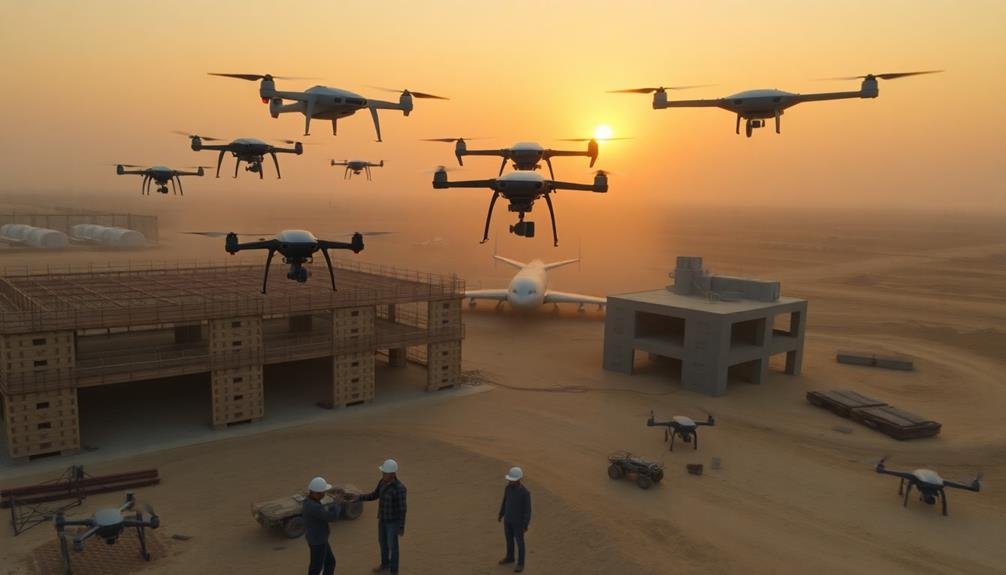
When it comes to choosing the right drone for your construction site monitoring needs, you'll need to contemplate several key factors.
First, consider the drone's flight time and range. You'll want a model that can cover your entire site without frequent battery changes. Look for drones with at least 30 minutes of flight time and a range of 5-7 kilometers.
Camera quality is essential for effective monitoring. Opt for a drone with a high-resolution camera, preferably 4K, and a good zoom capability. This will allow you to capture detailed images and videos of your site from various angles.
Durability is another important aspect. Construction sites can be dusty and windy, so choose a drone that's weather-resistant and can handle challenging conditions.
Consider models with obstacle avoidance systems to prevent collisions with cranes or other structures.
Legal and Regulatory Considerations
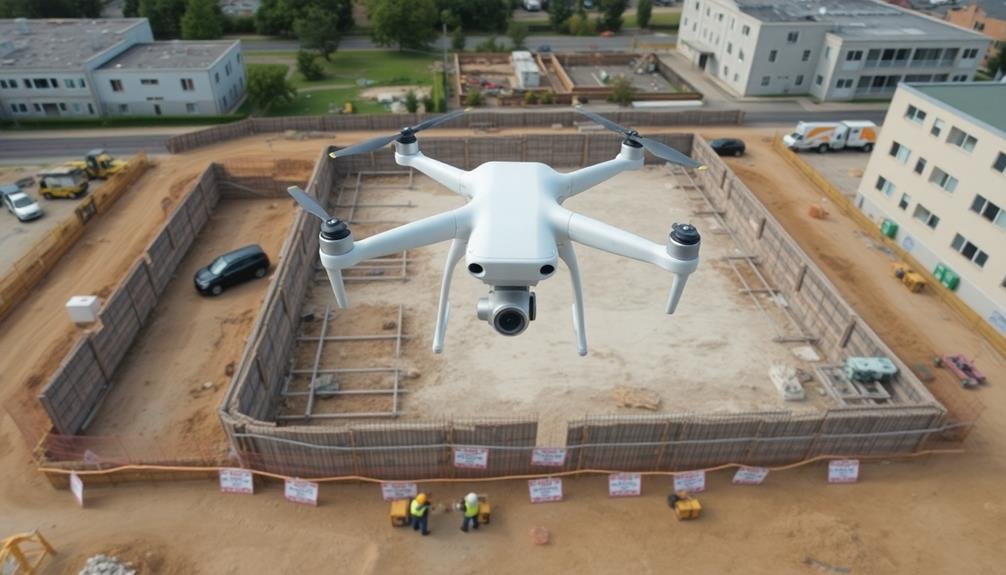
While selecting the right drone is essential, you must also navigate the complex web of legal and regulatory requirements for drone operations on construction sites. Familiarize yourself with local, state, and federal laws governing unmanned aerial vehicles (UAVs). Obtain necessary permits and licenses, including a Remote Pilot Certificate from the FAA if you're in the United States.
Guarantee compliance with airspace restrictions and privacy regulations. Notify nearby property owners and obtain consent when required. Implement safety protocols and maintain proper insurance coverage for your drone operations.
Here's a quick overview of key legal and regulatory considerations:
| Requirement | Description |
|---|---|
| Pilot Certification | Obtain FAA Remote Pilot Certificate |
| Drone Registration | Register your drone with the FAA |
| Flight Restrictions | Check for no-fly zones and airspace restrictions |
| Privacy Laws | Respect privacy rights and obtain necessary permissions |
Remember to stay updated on changing regulations and industry best practices. Consult with legal experts specializing in drone law to guarantee full compliance and mitigate potential risks associated with remote monitoring on construction sites.
Flight Planning and Safety
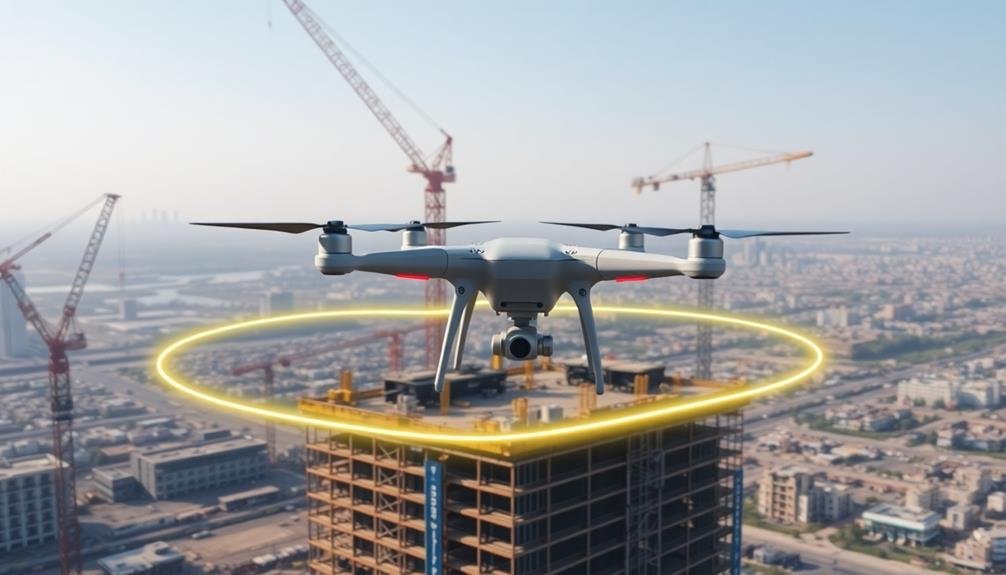
Before launching your drone for construction site monitoring, you'll need to complete a thorough pre-flight checklist to guarantee safety and compliance.
You must familiarize yourself with local airspace regulations and obtain necessary permissions to operate in the area.
It's essential to have a clear understanding of emergency procedures, including how to safely land your drone in case of unexpected issues or interference.
Pre-Flight Checklist Essentials
Guaranteeing a successful drone flight for remote construction site monitoring begins with a thorough pre-flight checklist. Before takeoff, you'll need to verify several critical elements to ensure safety and compliance.
Start by inspecting your drone's physical condition. Check for any visible damage, loose parts, or signs of wear. Confirm all propellers are securely fastened and undamaged. Next, assess your battery levels and confirm they're fully charged for the planned flight duration.
Review your flight plan and familiarize yourself with the construction site's layout, including potential obstacles and no-fly zones. Don't forget to check local weather conditions and adjust your flight plan accordingly.
Here's a quick reference table for your pre-flight checklist:
| Equipment | Environment | Regulations |
|---|---|---|
| Drone body | Weather conditions | Flight permissions |
| Propellers | Obstacles | Insurance coverage |
| Batteries | No-fly zones | Site-specific rules |
| Camera/sensors | Signal interference | Local regulations |
Lastly, test your remote control and camera systems to confirm proper functionality. By following this thorough pre-flight checklist, you'll minimize risks and maximize the efficiency of your construction site monitoring flights.
Airspace Regulations Compliance
How can you navigate the complex web of airspace regulations for drone flights over construction sites? Start by familiarizing yourself with local, state, and federal laws governing unmanned aerial vehicles (UAVs).
Verify you're operating within the bounds of FAA regulations, particularly Part 107 for commercial drone operations.
Before each flight, check for any temporary flight restrictions (TFRs) or notice to airmen (NOTAMs) that may affect your planned route. Use official FAA resources or approved apps to verify airspace classifications and restrictions in your area.
To maintain compliance with airspace regulations, follow these key steps:
- Obtain necessary certifications (e.g., Part 107 license for commercial operations)
- Register your drone with the FAA
- Adhere to altitude restrictions and maintain visual line of sight
- Respect no-fly zones and restricted airspace
Remember to keep detailed flight logs and documentation of your operations. This includes recording flight paths, altitudes, and any incidents or near-misses.
If your construction site is near an airport or in controlled airspace, you'll need to obtain proper authorization before flying.
Stay informed about changing regulations and be prepared to adapt your operations accordingly.
Emergency Procedures Overview
While airspace regulations are critical, your safety plan must also include robust emergency procedures. These procedures guarantee you're prepared for unexpected situations during your drone flights over construction sites.
First, establish a clear chain of command for emergencies. Designate a lead pilot and backup personnel who can take control if needed. Create a communication protocol using reliable devices to maintain contact between team members and site management.
Develop specific procedures for common emergencies:
- Loss of control: Implement fail-safe measures like return-to-home functions.
- Battery failure: Plan emergency landing zones and carry spare batteries.
- Collision avoidance: Train pilots in evasive maneuvers and obstacle detection.
- Weather changes: Set wind speed limits and monitor forecasts closely.
- Signal interference: Identify potential sources and have alternative flight plans ready.
Conduct regular emergency drills to verify your team can execute these procedures efficiently. Keep a thorough checklist on-site for quick reference during flights.
Update your emergency procedures regularly based on new regulations, technological advancements, and lessons learned from incidents or near-misses.
Data Collection Techniques
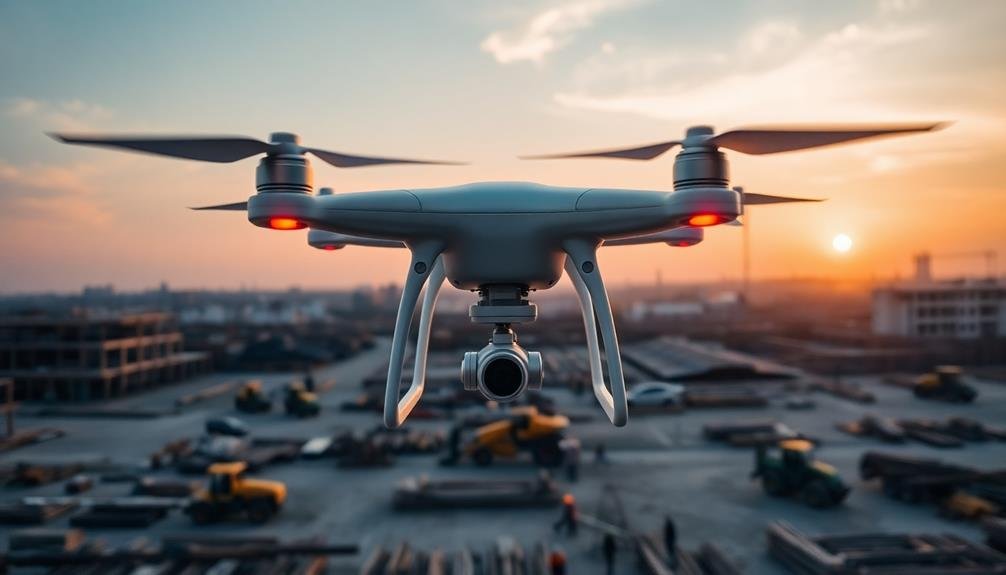
You'll find two primary methods for collecting data in remote construction site monitoring: aerial imaging and sensor-based gathering.
With aerial imaging, you're capturing high-resolution photographs and videos of the site from above, allowing for thorough visual analysis.
Sensor-based techniques involve deploying various devices across the site to measure specific parameters like temperature, humidity, or structural integrity, providing real-time data on site conditions.
Aerial Imaging Methods
Aerial imaging has revolutionized data collection techniques for remote monitoring of construction sites. You'll find that these methods offer unparalleled views and insights into your project's progress. By utilizing drones, satellites, or manned aircraft, you can capture high-resolution images and videos of your entire site from various angles and altitudes.
When implementing aerial imaging for your construction site, consider these four key methods:
- Drone photography: Use small, nimble UAVs to capture detailed images of specific areas or structures.
- LiDAR scanning: Employ laser technology to create precise 3D models of your site's topography and structures.
- Thermal imaging: Detect heat signatures to identify potential issues with insulation, electrical systems, or equipment.
- Multispectral imaging: Capture data across multiple wavelengths to assess vegetation health, soil conditions, and material properties.
These aerial imaging techniques provide you with extensive, real-time data that's essential for effective project management. You'll be able to track progress, identify potential issues, and make informed decisions quickly.
Sensor-Based Data Gathering
Beyond aerial imaging, sensor-based data gathering forms another crucial pillar of remote monitoring for construction sites. You'll find various types of sensors deployed across your site, each collecting specific data to enhance safety, efficiency, and project management.
Environmental sensors monitor air quality, temperature, humidity, and noise levels. They help you guarantee compliance with regulations and maintain ideal working conditions.
Structural sensors detect vibrations, stress, and movement in buildings and materials, alerting you to potential stability issues. GPS-enabled devices track the location and movement of equipment and personnel, maximizing resource allocation and improving site security.
You can also utilize wearable sensors for worker safety. These devices monitor essential signs, detect falls, and measure exposure to harmful substances.
IoT-enabled sensors on machinery collect data on performance, fuel consumption, and maintenance needs, allowing you to schedule preventive maintenance and reduce downtime.
To make the most of sensor-based data gathering, you'll need a robust data management system. This will help you analyze the collected information, generate real-time alerts, and create extensive reports for informed decision-making.
Image Processing and Analysis

How can construction sites leverage image processing and analysis for remote monitoring? By utilizing advanced algorithms and machine learning techniques, you can extract valuable insights from visual data captured by drones, cameras, and other imaging devices.
This technology allows you to automatically detect and analyze various aspects of your construction site, enhancing safety, productivity, and compliance.
Image processing and analysis offer several key benefits for remote monitoring:
- Automated progress tracking: Compare real-time images with project plans to assess completion rates and identify potential delays.
- Safety hazard detection: Quickly spot unsafe conditions, missing safety equipment, or unauthorized personnel in restricted areas.
- Equipment utilization optimization: Monitor the movement and usage patterns of machinery to improve efficiency and reduce idle time.
- Quality control: Identify construction defects, material inconsistencies, or deviations from design specifications early in the process.
Integrating With Project Management Software
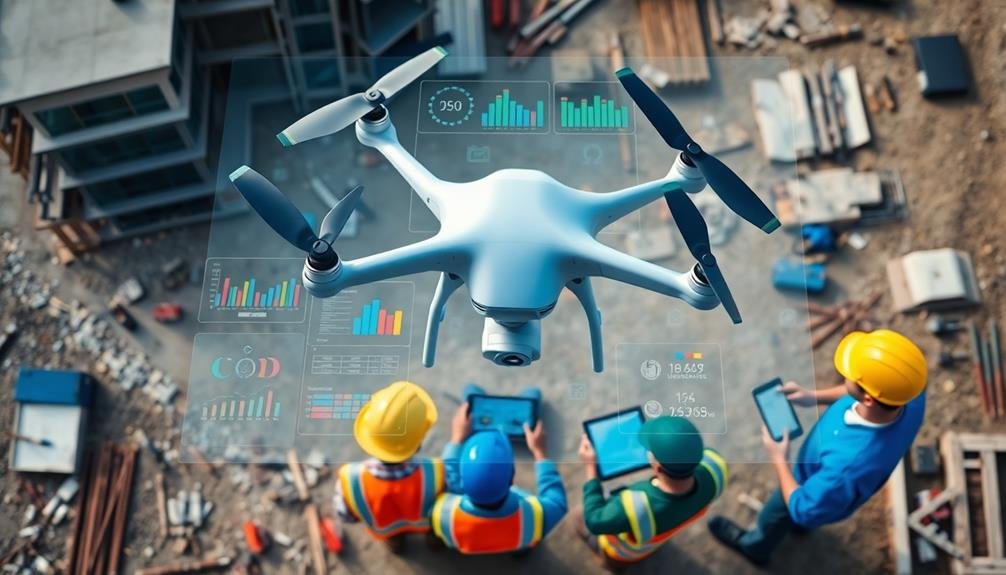
Three key benefits emerge when integrating remote monitoring systems with project management software. First, you'll achieve real-time data synchronization, allowing instant updates on site progress. Second, you'll streamline communication between field teams and office staff, reducing delays and misunderstandings. Third, you'll enhance decision-making with thorough, up-to-date information at your fingertips.
To effectively integrate these systems, consider the following best practices:
| Integration Step | Purpose | Key Consideration |
|---|---|---|
| API Connection | Data Exchange | Compatibility |
| Data Mapping | Alignment | Accuracy |
| Automation Rules | Workflow Efficiency | Customization |
| User Training | Adoption | Ease of Use |
Start by selecting project management software that offers robust API capabilities. Confirm your remote monitoring system can seamlessly connect and share data. Map data fields carefully to maintain consistency across platforms. Implement automation rules to trigger actions based on specific events or thresholds. Finally, train your team on the integrated system to maximize its benefits.
Training Drone Operators

While integrating monitoring systems enhances project management, the effectiveness of remote site surveillance often hinges on skilled drone operators. You'll need to invest in proper training to guarantee your team can safely and efficiently operate drones for construction site monitoring.
Start by familiarizing your operators with drone regulations and obtaining necessary certifications. In the US, this typically includes passing the FAA Part 107 exam.
Next, focus on developing their practical skills through hands-on training sessions. These should cover:
- Basic flight maneuvers and controls
- Camera operation and image capture techniques
- Site-specific flight patterns and protocols
- Emergency procedures and troubleshooting
Don't overlook the importance of site-specific training. Your operators should understand the unique challenges of flying over construction sites, including obstacle avoidance and maintaining visual line of sight.
Regular practice sessions in controlled environments will help build confidence and proficiency.
Consider partnering with professional drone training organizations or equipment manufacturers for specialized instruction. They can provide insights into advanced techniques and emerging technologies.
Maintaining Drone Equipment

For successful remote monitoring of construction sites, proper maintenance of your drone equipment is essential. Start by establishing a regular cleaning routine. After each flight, wipe down your drone's body, propellers, and camera lens with a microfiber cloth to remove dust and debris.
Pay special attention to the motors, making sure they're free from dirt that could affect performance. Inspect your drone's propellers frequently for chips, cracks, or warping. Replace them immediately if you spot any damage.
Check all connections and screws, tightening them as needed to prevent in-flight issues. Keep your batteries in top condition by storing them at around 50% charge in a cool, dry place. Avoid leaving them fully charged for extended periods.
Regularly update your drone's firmware to guarantee you have the latest features and security patches. Calibrate your drone's compass and IMU (Inertial Measurement Unit) before flights in new locations or after long periods of inactivity.
Frequently Asked Questions
How Long Does a Typical Drone Battery Last During Surveillance Flights?
You'll find that typical drone batteries last between 20-30 minutes for surveillance flights. However, flight time can vary based on the drone's model, payload, weather conditions, and flying style. Always carry spare batteries for longer missions.
Can Drones Operate Effectively in Adverse Weather Conditions Like Rain or Wind?
You'll find that drones can operate in some adverse weather, but their effectiveness is limited. Light rain and moderate winds are manageable, but heavy precipitation and strong gusts can compromise flight stability and image quality.
What's the Average Cost of Implementing a Drone Surveillance Program for Construction Sites?
You'll find drone surveillance costs vary widely. Expect to spend $10,000 to $50,000 initially for equipment, training, and software. Ongoing expenses include maintenance, data storage, and potential pilot salaries. Consider your site's size and needs when budgeting.
How Far Can Construction Site Drones Fly While Maintaining a Stable Connection?
You'll typically find construction site drones can fly 1-3 miles while maintaining a stable connection. However, it's crucial to emphasize that range varies based on drone model, terrain, and interference. Always check local regulations before flying.
Are There Any Special Insurance Requirements for Using Drones in Construction Surveillance?
You'll likely need specialized drone insurance for construction surveillance. It's essential to cover liability, property damage, and equipment. Check with your insurance provider and local regulations to guarantee you're properly protected for this specific use.
In Summary
You've now got the tools to revolutionize your construction site surveillance with drone technology. Remember to stay up-to-date on regulations, prioritize safety, and invest in proper training. By integrating drone data with your project management systems, you'll enhance decision-making and boost efficiency. Don't forget to maintain your equipment regularly. With these strategies in place, you're set to take your construction site monitoring to new heights – literally!

As educators and advocates for responsible drone use, we’re committed to sharing our knowledge and expertise with aspiring aerial photographers.
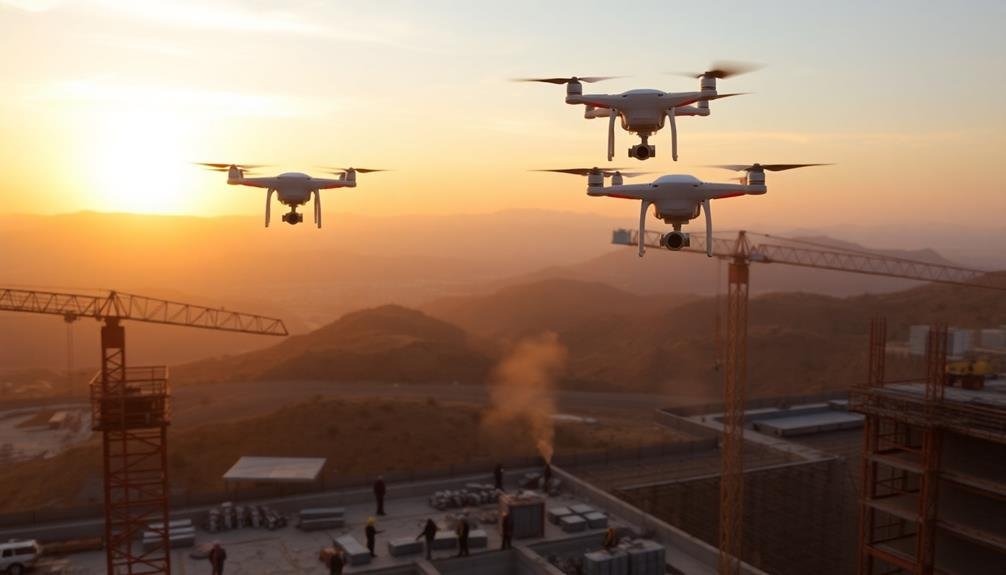



Leave a Reply